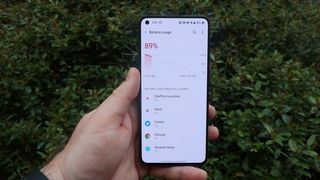What is an SoC?

We talk a lot about the parts inside an Android phone here. That's what we do, and the bits and pieces that make up a phone are a big part of what makes one good or bad. You'll read plenty of abbreviations for the distinct parts in reviews and comparisons alike.
Sometimes it's easy to forget that not everyone is a technophile who understands what all these names and acronyms mean. Some of these terms are important to understand, though, and the SoC is one of them. It's also a pretty simple concept for an extremely complex part that can make all the difference when it comes to the actual day-to-day performance of the phone you have now and the phone you might buy next.
SoC means System on Chip

The generic definition of a System on Chip is an integrated circuit that builds an entire platform onto it. Typically you'll find things like a CPU, a GPU, input and output ports, memory and cache, and more built into an SoC depending on what its purpose is. Because personal computers predate the smartphone, much of the jargon used inside a desktop PC has worked its way over, and so you also hear the terms chip or chipset used to describe a smartphone SoC.
We're specifically talking about a mobile device SoC in this article, which means one found inside a phone, a tablet, or a wearable. All mobile devices have an SoC — the best Android phones as well as the cheapest need one to do anything more than look good. And each of those SoCs is typically filled with the same components.
- The Central Processing Unit (CPU). Every device that electronically performs calculations needs some sort of processor, and a CPU is a type that not only performs those calculations but also acts as a gateway for all electronic operations. When you tap the screen to type a letter on the keyboard or hit a link to open a webpage, the CPU handles the task — hence the name "central."
- The Graphical Processing Unit (GPU). Calculations involving the display geometry and everything that appears on it funnels through the GPU. Some tasks are performed by the GPU directly through APIs like Open GL or Vulkan, while others are fed to the GPU from the CPU, so they can simply be drawn on the screen in the right spot at the right time.
- Signal Processors. Some tasks are better suited to be handled individually by a dedicated processor. Usually, these are more complex tasks that either need to be handled quickly or shouldn't tie up the CPU, so they are handed off to dedicated processors. On many phones, you'll find dedicated processors for the camera (ISP), sensor data and file manipulation (DSP), and dedicated AI tasks.
- Multimedia codecs (encoder and decoder). Video and audio files usually need some sort of digital conversion, and device encoders and decoders handle them faster and use less power than the CPU.
- Wireless communications. This includes Wi-Fi, Bluetooth, LTE, and 5G radios in addition to more niche technologies like NFC or Wi-Fi Direct. These are the assemblies that allow your phone to communicate with the outside world.
A mobile device doesn't have to have all of these parts integrated into its SoC, but some like the CPU and GPU will always be present. You'll also find plenty of crossover into the chips that power things like Chromebooks and even a more "traditional" stand-alone CPU from Intel (which usually integrates cache and internal memory as well as a GPU).
There is no absolute right or wrong way to build a mobile SoC.
There is no absolute right or wrong way to build an SoC; manufacturers should tailor SoCs for the devices it powers. It's also not a part made by the phone maker; even Samsung builds mobile SoCs for Galaxy devices in a completely separate business division.
What makes an SoC great?

Several different companies build the SoCs used in mobile devices, and by build, I mean design and sell, not fabricate. All of them make great SoCs, and all of them make bad SoCs because behind all the time, money, and engineering, there is a bit of trial and error. The goal is to deliver an acceptable level of performance without wasting excess energy, and sometimes things just turn out poorly.
Be an expert in 5 minutes
Get the latest news from Android Central, your trusted companion in the world of Android
A great SoC provides a balance of performance and power requirements.
The Qualcomm Snapdragon 888 is a great SoC. The Qualcomm Snapdragon 765 is an equally great SoC but in a different way. In fact, it's my opinion that the Snapdragon 765 is a better SoC than the Snapdragon 888 is, at least from a purely technical standpoint, because it delivers a better level of performance per unit of energy being used.
That doesn't mean a phone using the 765 will outperform one using the 888 because it simply won't. It can't because the components inside the Snapdragon 888 are faster and can seemingly do more things at once, but they use a lot more power to do so. In most cases, the extra power can be justified by the improved performance and extra options in the signal processing and connectivity department.

Power requirements are usually scaled about the same as the performance gains. Both have been designed to last throughout the day on a single charge in a typical smartphone (RIP Nexus 4). That difference isn't as noticeable, and we want to use a phone with a Snapdragon 888 inside of it. If smartphone batteries were very tiny, things might be very different.
Google's Tensor SoC could change how we look at a smartphone SoC, or it could be a flop.
Google has designed an in-house chip for the Pixel 6, and it could prove to be a fascinating SoC because it seems like the company isn't focused on using an ultra-powerful set of CPU cores to handle the work. Instead, Google focused on efficiency and companion processors to distribute the workload so that a powerful CPU isn't required.
Nobody knows how well or poorly this will work, but the company uses the same general idea for the SoCs powering its machine learning data centers, and it works great. Should this approach also work well inside a phone, we may see companies like Qualcomm and MediaTek follow suit.
There are different ways to build a great SoC, and no one way is better than another. Really, what you should focus on is the result of having the right SoC inside your phone so that it can handle the tasks you value most. Thankfully, we have a wealth of choices to pick from, from power-sipping to extreme gaming performance.

Jerry is an amateur woodworker and struggling shade tree mechanic. There's nothing he can't take apart, but many things he can't reassemble. You'll find him writing and speaking his loud opinion on Android Central and occasionally on Twitter.
